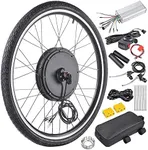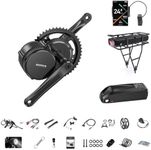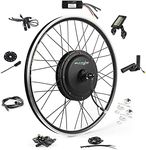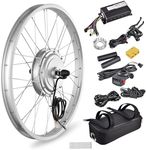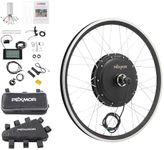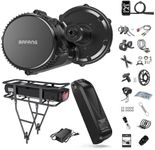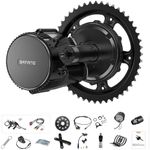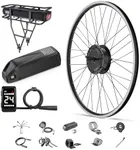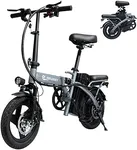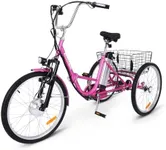Buying Guide for the Best Electric Bike Kits
Choosing the right electric bike kit can transform your regular bicycle into a powerful, efficient, and enjoyable mode of transportation. The key to making the best choice is understanding the various specifications and how they align with your needs. By focusing on the right specs, you can ensure that your electric bike kit will provide the performance, range, and ease of use that you desire.Motor PowerMotor power, measured in watts (W), determines how much assistance the motor provides. This is important because it affects the bike's speed and ability to handle inclines. Kits typically range from 250W to 1000W or more. For casual city riding and flat terrains, a 250W to 500W motor is usually sufficient. For hilly areas or if you want more speed and power, consider a 500W to 750W motor. For heavy-duty use or off-road riding, a 750W to 1000W motor or higher may be necessary. Choose based on the terrain you will be riding on and how much power you need.
Battery CapacityBattery capacity, measured in ampere-hours (Ah) or watt-hours (Wh), determines how far you can travel on a single charge. This is crucial for planning your rides and ensuring you don't run out of power. Batteries typically range from 10Ah to 20Ah or more. For short commutes and occasional rides, a battery with 10Ah to 13Ah should suffice. For longer rides or daily commuting, consider a battery with 14Ah to 17Ah. For extended trips or if you want to minimize charging frequency, look for a battery with 18Ah or more. Your riding distance and frequency will guide your choice.
Type of MotorThe type of motor, either hub motor or mid-drive motor, affects the bike's performance and maintenance. Hub motors are located in the wheel hub and are easier to install and maintain, making them ideal for casual riders. Mid-drive motors are located at the bike's crank and provide better weight distribution and efficiency, especially on hills, but they can be more complex to install and maintain. Choose a hub motor for simplicity and ease of use, or a mid-drive motor for better performance and efficiency, especially if you ride on varied terrains.
ControllerThe controller regulates the power from the battery to the motor and affects the smoothness and responsiveness of the ride. A good controller ensures efficient power use and a smooth riding experience. Controllers come in various types, with some offering more advanced features like regenerative braking or customizable settings. For basic use, a standard controller will suffice. If you want more control over your riding experience or advanced features, look for a controller with additional functionalities. Your preference for ride customization and efficiency will help you decide.
DisplayThe display shows important information such as speed, battery level, and distance traveled. This is important for monitoring your ride and managing battery usage. Displays range from simple LED indicators to advanced LCD screens with multiple functions. For basic information, a simple LED display is adequate. For more detailed information and features like trip tracking or navigation, consider an advanced LCD display. Your need for information and features during your ride will guide your choice.
Throttle vs. Pedal AssistThrottle and pedal assist are two ways to control the motor. Throttle allows you to control the motor with a hand lever, providing power without pedaling, which is useful for quick bursts of speed or when you need a break from pedaling. Pedal assist provides power as you pedal, making for a more natural riding experience and better battery efficiency. Some kits offer both options. Choose throttle if you want the option to ride without pedaling, pedal assist for a more integrated riding experience, or a kit with both for maximum flexibility.
CompatibilityCompatibility refers to how well the kit fits with your existing bike. This is crucial to ensure a smooth installation and proper functioning. Check the specifications of the kit to ensure it matches your bike's frame, wheel size, and brake type. Some kits are designed for specific types of bikes, such as mountain bikes or road bikes. Make sure to choose a kit that is compatible with your bike's specifications to avoid installation issues and ensure optimal performance.
